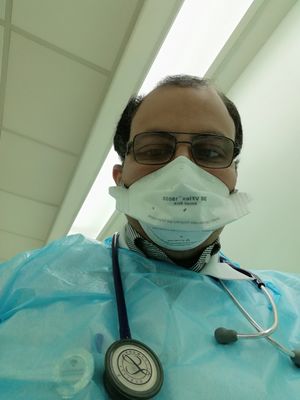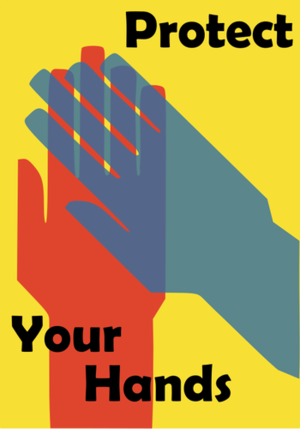Infection Prevention and Control
Original Editor '- Rewan Elsayed Elkanafany
Top Contributors - Shaimaa Eldib, Kim Jackson, Naomi O'Reilly, Richard Benes, Rachael Lowe, Lucinda hampton, Wanda van Niekerk, Shreya Pavaskar, Rewan Elsayed Elkanafany, Tarina van der Stockt, Jess Bell, Admin, Khloud Shreif, Tony Lowe, Stacy Schiurring, Simisola Ajeyalemi, Vidya Acharya, Tolulope Adeniji and Laura Ritchie
Introduction[edit | edit source]
According to the World Health Organization (WHO), infection prevention and control (IPC) is a scientific approach and practical solution designed to prevent harm caused by infection to patients and health workers. It is a subset of epidemiology, but also serves an essential function in infectious diseases, social sciences and global health[1]. Effective IPC is a public health issue that is fundamental in patient safety and health system strengthening. The prevention of healthcare-associated infections (HAI), epidemics (including the 2013-2016 Ebola virus disease outbreak), and pandemics of international concern (ie. 2009 flu pandemic and the coronavirus disease 2019) are rooted in effective IPC measures[2]. A guiding principle on WHO's core components of IPC is that "access to health care services designed and managed to minimize the risks of avoidable HAI for patients and health care workers is a basic human right[2]."
What is an Infection?[edit | edit source]
Infection is defined as the successful transmission of a microorganism to the host with subsequent multiplication, colonization and invasion.Infection could be clinical or sub clinical and may not produce any identifiable disease[3][4][5].
Epidemiology is defined as the study of the factors determining the occurrence of disease in human population[5][6] .The threats posed by epidemics, pandemics and antimicrobial resistance (AMR) have become significantly evident as ongoing universal challenges and they are now recognized as a top priority for action on the global health agenda. Effective IPC is the cornerstone of such action.[2]
Infection Control and Prevention[edit | edit source]
Infection control and prevention is a global issue,especially in healthcare facilities where we have a duty to keep patient's who may have lower immune defences, safe and free from infection.HAIs are one of the most common detrimental effects in care delivery and both the endemic burden and the occurrence of epidemics are a major public health problem. HAIs have a significant impact on morbidity, mortality[7] and quality of life and present an economic burden at the societal level.However, a large proportion of HAI are preventable and there is a growing body of evidence to help raise awareness of the global burden of harm caused by these infections, including strategies to reduce their spread.As, up to 7% of patients in developed and 10% in developing countries will acquire at least one HAI[2][8]
Infection control and prevention can work effectively using 6 main themes[1][edit | edit source]
- Leadership[9]
- connecting and coordinating[10]
- Campaigns and advocacy
- Technical guidance and implementation
- Capacity-building
- Measuring and learning
Examples of Infection Control[edit | edit source]
There are many areas in which infection control can be implement: [1][4][5]
- Hand hygiene[11][12]
- Prevention of surgical site infections
- IPC to combat antimicrobial resistance
- Injection safety
- Burden of health care-associated infections
- Ebola response and recovery
- IPC country capacity-building
- Prevention of sepsis and catheter-associated bloodstream infections
- Prevention of catheter-associated urinary tract infections.(CAUTI)
- Isolation precautions Multidrug-resistant organisms (MDRO)
- Intravascular catheter-related infection (BSI)
- Organ transplantation Surgical site infection (SSI)
- Norovirus Pneumonia prevention Dialysis
- Infection Control in Healthcare Personnel
- Post exposure Prophylaxis in Healthcare Workers
Infection Control for Acute Care Hospitals[edit | edit source]
To assist in the assessment of infection control programs and practices in acute care hospital the Centers for Disease Control and Prevention suggest that management can be divided into 4 sections:
it s divided into 4 sections:
- Section 1: Facility Demographics
- Section 2: Infection Control Program and Infrastructure
- Section 3: Direct Observation of Facility Practices (optional)
- Section 4: Infection Control Guidelines and Other Resources
Environmental Cleaning/Disinfection[edit | edit source]
If a suspected or confirmed case an infectious disease has attended your clinic, all surfaces that the person has come into contact with must be cleaned.
- The room where they were placed/isolated should not be cleaned or used for one hour and the door to the room should remain shut
- The person assigned to clean the room should wear gloves (disposable single use nitrile or household gloves) and a disposable apron (if one is available) then physically clean the environment and furniture using a household detergent solution followed by a disinfectant or combined household detergent and disinfectant for example one that contains a hypochlorite (bleach solution)
- Products with these specifications are available in different formats including wipes.
- No special cleaning of walls or floors is required
- Pay special attention to frequently touched flat surfaces, backs of chairs, couches, door handles or any surfaces that the affected person has touched.
- Discard waste including used tissues, disposable cleaning cloths)into a healthcare risk waste bag or if one is not available place
- Remove the disposable plastic apron (if worn) and gloves and discard into a healthcare risk waste bag.
- If a healthcare risk waste bag (yellow) is not available, place the waste in a small household waste bag and tie securely. Do not overfill. Then place the bag in a second household waste bag and tie securely. Store is a safe location. If the case is not confirmed the waste can be disposed of as per usual. If a case is confirmed public health will then advise you what to with the waste.
- Once this process has been completed and all surfaces are dry the room can be put back into use.
Resources[edit | edit source]
The following resources expand further on the four sections mentioned above https://www.cdc.gov/infectioncontrol/pdf/icar/hospital.pdf
https://www.publichealthontario.ca/-/media/documents/checklist-clinical-office-core.pdf?la=en
References[edit | edit source]
- ↑ 1.0 1.1 1.2 WHO.infection prevention&control .Available from:https://www.who.int/infection-prevention/about/ipc/en/
- ↑ 2.0 2.1 2.2 2.3 World Health Organization. Guidelines on core components of infection prevention and control programmes at the national and acute health care facility level. World Health Organization; 2016.
- ↑ Mayhall CG. Hospital epidemiology and infection control. Lippincott Williams & Wilkins; 2012 Feb 20.
- ↑ 4.0 4.1 CDC centers for disease control and prevention.infection control. Available from:https://www.cdc.gov/infectioncontrol/index.html
- ↑ 5.0 5.1 5.2 Wilson J. Infection control in clinical practice. Elsevier Health Sciences; 2006 Jun 21.
- ↑ Wilson J. Infection control in clinical practice. Elsevier Health Sciences; 2006 Jun 21.
- ↑ Borg MA. Cultural determinants of infection control behaviour: understanding drivers and implementing effective change. Journal of Hospital Infection. 2014 Mar 1;86(3):161-8.
- ↑ Sydnor ER, Perl TM. Hospital epidemiology and infection control in acute-care settings. Clinical microbiology reviews. 2011 Jan 1;24(1):141-73.
- ↑ Gould DJ, Gallagher R, Allen D. Leadership and management for infection prevention and control: what do we have and what do we need?. Journal of Hospital Infection. 2016 Oct 1;94(2):165-8.
- ↑ Kretzer EK, Larson EL. Behavioral interventions to improve infection control practices. American journal of infection control. 1998 Jun 1;26(3):245-53.
- ↑ Pittet D. The Lowbury lecture: behaviour in infection control. Journal of hospital infection. 2004 Sep 1;58(1):1-3.
- ↑ Boyce JM, Pittet D. Guideline for hand hygiene in health-care settings: recommendations of the Healthcare Infection Control Practices Advisory Committee and the HICPAC/SHEA/APIC/IDSA Hand Hygiene Task Force. Infection Control & Hospital Epidemiology. 2002 Dec;23(S12):S3-40.
- ↑ Health portal Infection control, Available from: https://www.youtube.com/watch?v=QgqTW0FjN08 (last accessed 22.4.2019)








